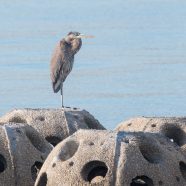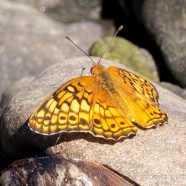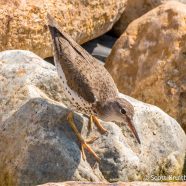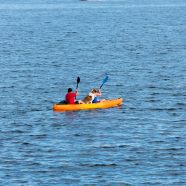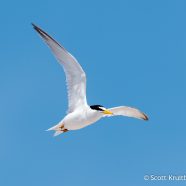Great Blue Heron
Check out this Great Blue Heron (Ardea herodias) sitting on one of the new reef balls at Stratford Point. I’m glad it found the spot inviting! Yes, new reef balls have been put in place along the north shore to expand on the success of the pilot project, and I will show and tell you more about them in an upcoming post. Now if a Snowy Owl could be sitting on one in the next couple of weeks I would not object… Scott Kruitbosch Conservation & Outreach Coordinator
Read MoreVariegated Fritillary (Euptoieta claudia)
This Variegated Fritillary (Euptoieta claudia) was an unexpected shore surprise last month as I had it fluttering along the rocks just above the tidal zone. It was a cool and breezy day, and the butterfly was trying to warm up like this when it could in between short flights. It looked to be on a mission to somewhere, and I hope it got where it wanted to go. Scott Kruitbosch Conservation & Outreach Coordinator
Read MoreSpotted Sandpiper
The Spotted Sandpiper (Actitis macularius) is one of our easier to identify shorebirds from any distance, and their unique behaviors make them a stand out from the crowd – literally. While you may run into large flocks of shorebirds numbering in the dozens, hundreds, or even thousands heading south in the summer along lakes, in marshes, or on the Atlantic coast, you will very likely find only one or two or a handful of Spotted Sandpipers at a time. Even if multiple Spotteds are present in one place they will probably be on different flocks, not bumping into one another or seeking the...
Read MoreKayaking Dogs
This scene is one that has personally appalled me all spring and summer long as hundreds of people have been seen by our staff and volunteers kayaking offshore with their dogs in this apparently growing fad. To each their own, though I do wish more safety precautions were taken here…life jackets are for wearing, you know, and they do no good when you’re already in the water or injured. Regardless, so many people and dogs in kayaks among the sizable and fast boats in Long Island Sound seem to enjoy landing on various beaches and offshore islands in order to stretch their legs, run...
Read MoreLeast Tern
This summer has been a “late” one for some of our waterbirds with species like the Piping Plover still nesting into July, a full three months after some of their counterparts had started a new family. Our work in the Audubon Alliance for Coastal Waterbirds focuses primarily on four species – those Piping Plovers, the American Oystercatcher, plus Common and Least Terns. Both of the terns arrive back in Connecticut right around May 1 each spring. They check out the menus, get the lay of the land and see what has changed over the beach-shaping winter months, push through the...
Read More



